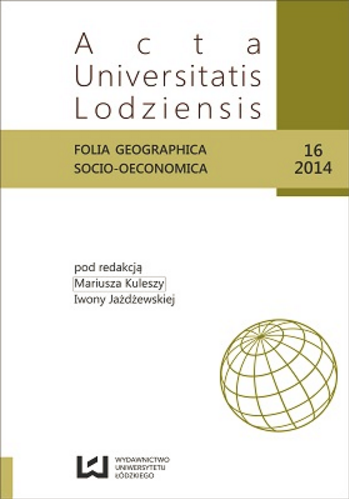Zastosowanie metody krigingu Poissona w badaniach rozkładu przestrzennego problemów społecznych na przykładzie Poznania
Poisson kriging as a tool for social problems analysis - Poznań case study
Author(s): Alfred Stach, Patrycja WysockaSubject(s): Economy, Geography, Regional studies
Published by: Wydawnictwo Uniwersytetu Łódzkiego
Keywords: social problems; Poznań; socio-spatial structure; Poisson kriging method
Summary/Abstract: Planning of social policy it is complicated and multidimensional issue, especially in complex urban structures characteristic for big cities. However econometric indicators of spatial dependence provide us some information about spatial autocorrelation, their do not show the differences in local variability. Geostatistics is an answer for this challenge. This method is not only helpful in more accurate determination of the most important problems but it also enables identification of their location, scale and possible reasons. This paper presents possibilities given by Poisson Kriging for analysis of social problems in urban space. Its was applied in Poznań for identification of neighbourhoods or local communities (related to the basic administrative units called „osiedla”) in which concentration of people needing social help is bigger than population distribution might it suggest. The data used in the analysis was taken from urban centre helping families in difficult social situation (MOPR). They concerns people who received financial support in 2008. The basic information taken into account was their place of residence and the reason for which they received financial aid. MOPR distinguish 13 categories of social problems needing support, including poverty, chronic diseases, alcoholism and domestic violence. 9 473 persons received financial aid in the analysed period of time. Taking into account their families it give us at least 18 264 people struggling with social problems – 3,3% of the city population (545 000 inhabitants). In order to receive comparable measure of issues analysed in urban space, the number of people needing social support must be compared with the population distribution. Thus, information about place of residence of people who receives financial aid was aggregated to bigger areas – 731 regular polygons for which the number of city inhabitants was know. Side length of single polygon was 500 meters. In each polygon data needed also to be age-adjusted. It is very sophisticated task, therefore special script dedicated for ArcGIS was created. The age-adjusted data aggregated in the polygons were bases for main spatial analysis. Application of Poisson Kriging resulted in more precise identification of areas affected by the major social problems in Poznań. Presence of autocorrelation was noticeable in case of majority of analysed social problems. The most common ranges of autocorrelation were 1‒1,2 km (which is similar to the spatial range of single local communities) and 6–6,5 km (the range of single neighbourhoods). Analysis showed that there are some neighbourhoods in Poznań where occurrence of social problems is significantly higher than mean occurrence for the whole city. Presented method enabled smoothing of unreliable, extremely high relative risks values but without loss of the local variability.
Journal: Acta Universitatis Lodziensis. Folia Geographica Socio-Oeconomica
- Issue Year: 16/2014
- Issue No: 1
- Page Range: 169-188
- Page Count: 20
- Language: Polish

